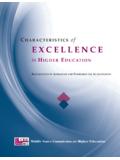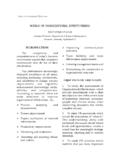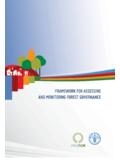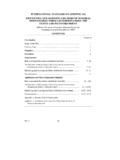Transcription of Assessing Student Learning and Institutional …
1 Assessing Student Learning and Institutional effectiveness Understanding Middle States Expectations Middle States Commission on Higher Education Published by the Middle States Commission on Higher Education 3624 Market Street, Philadelphia, PA 19104. 267-284-5000. Copyright 2005 by the Middle States Commission on Higher Education All rights reserved. Printed in the United States of America 2. Assessing Student Learning and Institutional effectiveness Understanding Middle States Expectations In 2002, the Middle States Commission on Higher Education introduced updated accreditation standards that simplified requirements for resources and processes and concentrated instead on assessment: evidence that the institution is achieving its goals. Every accreditation standard now includes an assessment component; the assessment of Student Learning is addressed in Standard 14.
2 (Assessment of Student Learning ); and the assessment of all key Institutional goals, including those assessed in the other thirteen standards, is addressed holistically in Standard 7 ( Institutional Assessment). Because Standards 7 and 14 are a significant change from prior standards, and because the Commission gives institutions great latitude in choosing approaches to comply with them, these two standards have engendered many questions. This statement is intended to address these questions and to clarify the Commission's expectations regarding these standards and their relationship to other standards such as Standard 2 (Planning, Resource Allocation, and Institutional Renewal). What is the Assessment of (Standard 14). Self-studies can thus document Institutional effectiveness compliance with Standard 7 by summarizing the assessments within each accreditation standard (Standard 7)?
3 Into conclusions about the institution's overall achievement of its key goals. Assessment may be characterized as the third element of a four-step planning-assessment cycle: 1. Defining clearly articulated Institutional and What is the Assessment of unit-level goals; Student Learning 2. Implementing strategies to achieve those goals; (Standard 14)? 3. Assessing achievement of those goals; and Assessment of Student Learning may be 4. Using the results of those assessments to characterized as the third element of a four-step improve programs and services and inform teaching- Learning -assessment cycle that parallels planning and resource allocation decisions. the planning-assessment cycle described above: The effectiveness of an institution rests upon 1. Developing clearly articulated Learning the contribution that each of the institution's outcomes: the knowledge, skills, and programs and services makes toward achieving competencies that students are expected to the goals of the institution as a whole.
4 Standard 7 exhibit upon successful completion of a course, ( Institutional Assessment) thus builds upon all academic program, co-curricular program, general other accreditation standards, each of which education requirement, or other specific set of includes periodic assessment of effectiveness as experiences;. one of its fundamental elements. This standard ties together those assessments into an integrated 2. Offering courses, programs, and experiences whole to answer the question, As an Institutional that provide purposeful opportunities for students community, how well are we collectively doing to achieve those Learning outcomes;. what we say we are doing? and, in particular, 3. Assessing Student achievement of those How do we support Student Learning , a Learning outcomes; and fundamental aspect of Institutional effectiveness ?
5 3. Team Visits: Conducting and Hosting an Evaluation Visit 4. Using the results of those assessments to What Are the Characteristics of improve teaching and Learning and inform planning and resource allocation decisions. Assessment Processes that Meet Because Student Learning is a fundamental Middle States Expectations? component of the mission of most institutions of higher education, the assessment of Student Effective assessment processes are useful, Learning is an essential component of the cost-effective, reasonably accurate and truthful, assessment of Institutional effectiveness carefully planned, and organized, systematic, and (Standard 7) and is the focus of Standard 14 sustained. (Assessment of Student Learning ). 1. Useful assessment processes help faculty and staff make appropriate decisions about improving programs and services, developing goals and Why Does the Commission Expect plans, and making resource allocations.
6 Because Student Learning and Institutional institutions, their students , and their environments are continually evolving, effective assessments effectiveness to be Assessed? cannot be static; they must be reviewed periodically and adapted in order to remain The fundamental question asked in the useful. accreditation process is, Is the institution fulfilling its mission and achieving its goals? This is 2. Cost-effective assessment processes yield precisely the question that assessment is designed dividends that justify the institution's investment to answer, making assessment essential to the in them, particularly in terms of faculty and staff accreditation process. Assessment processes help time. To this end, institutions may begin by to ensure that: considering assessment measures, indicators, flags, and scorecards already in place, such as Institutional and program-level goals are clear to retention, graduation, transfer, and placement the public, students , faculty, and staff.
7 Rates, financial ratios, and surveys. New or refined Institutional programs and resources are measures may then be added for those goals for organized and coordinated to achieve Institutional which evidence of achievement is not already and program-level goals. available, concentrating on the institution's most important goals. Effective assessments are simple The institution is indeed achieving its mission rather than elaborate, and they may focus on just and goals. a few key goals in each program, unit, and The institution is using assessment results to curriculum. improve Student Learning and otherwise advance 3. Reasonably accurate and truthful assessment the institution. processes yield results that can be used with confidence to make appropriate decisions. Because there is no one perfectly accurate assessment tool or strategy, institutions should use multiple kinds of measures to assess goal achievement.
8 Assessments may be quantitative or qualitative and developed locally or by an external organization. All assessment tools and strategies should clearly relate to the goals they are Assessing and should be developed with care;. they should not be not merely anecdotal information nor collections of information that happen to be on hand. Strategies to assess Student Learning should include direct clear, visible, and convincing evidence, rather than solely indirect evidence of Student Learning such as surveys and focus groups. 4. Team Visits: Conducting and Hosting an Evaluation Visit 4. Planned assessment processes that are V assessment results demonstrating that the purposefully linked to Institutional goals promote institution and its students are achieving attention to those goals and plans and ensure that key Institutional and program goals; and disappointing outcomes are appropriately V uses of assessment results to improve addressed.
9 Institutions often have a variety of Student Learning and advance the plans, such as a strategic plan, academic plan, institution. financial plan, enrollment plan, capital facilities master plan, and technology plan. Just as such plans should be interrelated to ensure that they How Should This Information work synergistically to advance the institution, assessments should also be interrelated. At many Be Organized and Formatted for institutions, effective Institutional planning begins Review by the Commission and with academic planning, which in turn drives the its Representatives? other plans. If the academic plan calls for a new academic program, for example, the technology Assessment documentation that is organized into plan should ensure faculty and students in the a coherent presentation of what the institution is new program will be able to use appropriate doing regarding assessment provides a roadmap instructional technologies.
10 Assessments of the that facilitates the work of evaluation teams, technology plan should evaluate not just whether reviewers, and the Commission. Assessment instructional technologies have been put in place documentation is typically a living, fluid, but also how effectively those technologies have organized collection of documents and/or online helped students to achieve the program's key resources, often with references and/or links to Learning outcomes. further documents and online resources, that are 5. Organized, systematized, and sustained routinely updated as the institution's assessment assessment processes are ongoing, not processes evolve. There is not, however, any once-and-done. There should be clear prescribed format or organization for these interrelationships among Institutional goals, materials; institutions have maximum flexibility in program- and unit-level goals, and course- designing and assembling assessment level goals.











